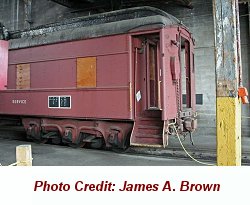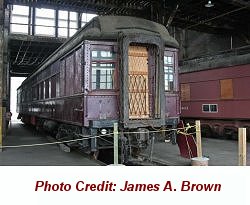


Canadian Pacific "Jackman"
 |
A so-called heavyweight 14-section sleeper later modified for work train service.
Jackman was constructed by Canadian Car & Foundry of Montreal in 1931. It is a good example of the standard type of economy overnight accommodation operated on Canadian railways until the streamliner era (ca. 1955). The accommodation consisted of seven sets of upper and lower berths or bunks along each side of the car. During the day, the lower berth converted into a pair of facing coach seats; at night, these seats became one bed and an upper berth or bed folded down out of the wall and ceiling area. Only the lower berth had a window. Privacy was assured by the hanging of heavy curtains in the aisles. To access the upper berth, it was necessary to climb a small ladder. Beds were prepared, curtains arranged and ladders provided by sleeping car porters, a profession traditionally reserved for black men. At each end of the car, there was a large washroom - one for men, with a smoking lounge, and one for women, without a smoking lounge but with additional sinks, mirrors and other amenities. These cars were generally not air conditioned until after 1945. Jackman is a good representative of the generation of all-steel passenger cars used in North America after 1918. Prior to the First World War, most passenger cars were constructed of wood or some combination of wood superstructure and a steel or iron frame. Jackman is described as a heavyweight because it is actually ballasted with concrete to make it even heavier than its steel construction and interior appointments would make it. Up to thirty tons of concrete would be added during the construction process, mainly between major frame members; it was believed that this additional weight helped the long-wheelbased six-wheel trucks or bogies produce a smoother ride over the jointed mainline rail of the period. These cars often weighed 90 tons or more. Subsequent streamlined lightweight cars did not contain concrete ballast and were constructed of lighter materials such as stainless steel or even aluminum. They would weigh about 60 tons. This allowed for longer trains and higher speeds, but ride quality was sometimes an issue. Such cars were widely used by families, commercial travellers (salesmen with territories), in troop trains and by immigrants. It is in the latter connection that we believe Jackman has the most significance for Toronto, as several successive waves of immigration moved up from Halifax, Saint John and the St. Lawrence River ports to this City in just such cars on the Canadian Pacific or Canadian National. Just as Pier 21 is the Ellis Island of Canada, so, too, Jackman is part of the story of the arrival of hundreds of thousands of new Canadians in this City. The car today is in rough condition. The mahogany inlaid woodwork inside has been painted over; the interior paint is peeling badly and the original varnished finish is reappearing from beneath. The tarpaper roof is badly decayed and needs replacement, probably with a sheet steel or rubber membrane roof; some of the interior sections or berths are missing, as are walls of one of the large washrooms. Nevertheless, we consider the car eminently restorable and plan to make it a keynote of our display on the history of immigration, railways and the development of Toronto. This car has been generously donated by the Upper Canada Railway Society to the City of Toronto. |
Canadian Pacific "Cape Race"
 |
The Cape Race was built for the Canadian Pacific Railway in 1929 as the "River Liard." The car was one of a series of 15 "River" cars fabricated at National Steel Car in Hamilton for $66,300 apiece. The opulent interiors were finished at CP's Angus Shops in Montreal and featured individual ladies's and gentlemen's showers, leather-upholstered smoking rooms, ladies' lounge and observation parlour as well as a small buffet to serve snacks and beverages.
Instead of the traditional open observation platform on the rear, the cars featured a high-windowed solarium furnished with eight leather chairs. In an era long before exposure to the sun's ultra-violet rays was considered harmful, CP promoted these solarium-lounge cars with their "health-giving VITA GLASS Sun Parlors." The River cars were unusual in that they contained no revenue-producing space; they were completely for the comfort of passengers occupying space in other sleeping cars. The cars were built primarily for CP's "Trans-Canada Limited," an all-sleeping car train between Montreal/Toronto and Vancouver that ran in the summers only between 1919 and 1930. In the winter, the cars operated on the Toronto-Vancouver "Dominion" as well as other CP trains. In 1931, due to the deepening Depression, CP cancelled the Trans-Canada Limited and mothballed most of the River cars since they were too expensive to operate. In 1941, with heavy demands on the CPR's equipment due to World War II, the River Liard was renamed "Cape Liard" and was air-conditioned. The lounges and showers were taken out and replaced with revenue producing sleeping accommodation: a compartment and four double bedrooms. The car was renamed "Cape Race" in 1947 when CP decided, in a postwar mood of heightened nationalism, to rename many of their passenger cars in order to reflect a less British and more Canadian mien. Cape Race was located on the southeastern corner of Newfoundland, soon to be Canada's newest province. In 1912, a powerful Marconi wireless receiving and transmission station was located at Cape Race and was the first to pick up distress calls from the sinking Titanic and relay them to the rest of the world. Following the renaming, Cape Race saw service on Montreal-Toronto trains and the transcontinental Dominion until that train was re-equipped with stainless steel cars in 1954. "Cape Race" was converted to Business Car 13 in 1963 and used by the CP superintendent based in Kenora, Ontario. In 1969 the car was sold to the Upper Canada Railway Society. The UCRS used the car to bring up the rear of their frequent railfan excursions that operated out of Toronto. Cape Race also functioned as a clubhouse for UCRS board members while stored in Toronto yards. Over time both CN and CP became less receptive to hauling excursions, particularly with equipment that didn't belong to them. The car had also become prohibitively expensive to maintain and operate and was retired by UCRS in the 1970s. Cape Race was moved around to various locations as the railway lands were redeveloped and finally ended up in the John Street Roundhouse, where it currently resides. This car has been generously donated by the Upper Canada Railway Society to the City of Toronto. |